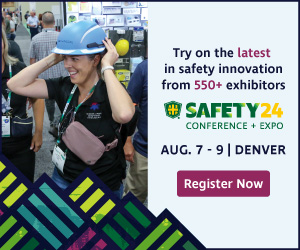History and Rise of No-Touch Decontamination for Workspaces
Ronald D. Brown, MD, Contributor

“No-touch” decontamination technologies played a key role in helping reduce the risk of infection during the pandemic and now continue to be widely used to maintain healthy workspaces. (fotoinfot – stock.adobe.com)
Not much was known about the transmission of disease until the mid-1800s. As science revealed that small organisms called germs can cause disease, approaches to disinfection began to evolve to help stop the spread of germs.
According to research, even before germ theory was formulated, “fumigation” was performed by burning sulfur and other chemical mixtures to act as a disinfectant. By the early 1900s, sulfur dioxide fumigation became a common disinfectant practice to prevent the spread of infectious diseases, such as cholera, yellow fever and tuberculosis. Around the same time, Formaldehyde gas was used to disinfect rooms and their contents. In the 1960s, formaldehyde, a carcinogen, was replaced by aerosolized chemicals to fight germs.
Today, advancements in science have moved disinfectant technology light years ahead to reduce the threat of disease transmission in public spaces, such as hospitals, schools and commercial spaces (like industrial facilities). In fact, “no-touch” decontamination technologies played a key role in helping reduce the risk of infection during the pandemic and now continue to be widely used to maintain healthy workspaces.
Types of No-Touch Decontamination Systems
No-touch decontamination (NTD) refers to technology that decontaminates or disinfects surfaces without any physical contact, removing or reducing human involvement to help eliminate the risk of cross-contamination. Some of the more commonly used NTD technologies include aerosolized hydrogen peroxide systems, vaporized hydrogen peroxide systems, electrostatic spraying and UV light.
Aerosolized Fogging Systems
Aerosolized fogging systems are designed to generate an aerosolized dry-mist fog that dispenses a specific amount of disinfectant. The machine dispenses the disinfectant by creating droplets that are small enough to disperse evenly throughout the environment, while being large enough to not evaporate too quickly. The machine must dispense enough disinfectant to evenly coat the surfaces. Some units also have a hand spray attachment useful for quick decontamination of equipment or high-touch areas of rooms, etc. Examples of disinfectants used in these types of systems include chlorine dioxide solutions, such as Vital Oxide and hydrogen peroxide.
Electrostatic Spraying
Electrostatic sprayers are disinfection chemical atomizers that spray an electrostatically charged mist onto surfaces and objects. Benefits of electrically charging the droplets include increasing their adherence to surfaces; however, the high voltage required to charge the particles adds some increased risk to the user, as well as increased system complexity and cost.
UV Light
Ultraviolet light-based disinfection systems use pulses of irradiated UV-C light to kill pathogens on surfaces. This light naturally damages the DNA and RNA of microorganisms, rendering them unable to replicate. Although quick and chemical-free, UV light works in direct line-of-sight only. For example, to ensure complete coverage of a room and contents being deconned, the unit must be moved to several different positions within the space. Additionally, the replacement cost of the UV light bulbs can be on the expensive side.
Benefits of No-Touch Decontamination Systems
NTD systems are designed to supplement regular manual cleaning processes, providing an extra layer of protection that eliminates harmful pathogens in workspaces. While manual cleaning removes dirt, grime and germs from surfaces, disinfecting has the power to kill harmful germs that remain on surfaces after cleaning. NTD technologies improve disinfection outcomes; reduce the risk of human error; eliminate the transfer of bacterial pathogens; and create a healthier work environment.
Disinfection technologies like this eliminate cross-contamination and provide full coverage of all surfaces. This approach to disinfecting spaces also saves time, with some systems able to decontaminate rooms and equipment for spaces up to 5,000 cubic feet in under 30 minutes.
These systems are also easy and safe to use, delivering the correct level of disinfectant for decontamination and doing so without damaging surfaces or equipment. Aerosolized dry-mist fogging NTD systems are also extremely effective at killing airborne germs and bacteria, eliminating pathogens on surfaces like walls, floors and ceilings and reaching all the nooks and crevices that other disinfectant methods just can’t reach.
The effectiveness of NTD systems delivers significant ROI by decreasing sick leave and reducing the labor and work hours devoted to decontamination—all of which result in considerable cost-savings. The benefits don’t stop there. Organizations with a healthy work environment see increases in overall health, productivity and morale.
Cleaning and disinfecting are a priority for all sectors including industrial workspaces that often struggle with a variety of contaminants, such as bacteria, viruses, mold, mildew and fungi that can negatively impact everyday operations. Advancements in disinfectant technology are helping to combat these issues.
Approaches to decontamination have evolved over the years from the use of a gaseous air pollutant like sulfur dioxide to the use of safe, environmentally friendly, technologically advanced NTD systems. Companies today need proven germ-fighting technologies that seamlessly integrate into their day-to-day cleaning routines to eliminate pathogens on environmental surfaces that contribute to the transmission of germs and diseases. IHW
About the Author:
Ronald D. Brown, MD, is the CEO of AeroClave, a leading distributor of decontamination systems that was founded in response to the 2003 SARS epidemic. He has decades of experience in emergency medicine, acting as the EMS Medical Director for the Seminole County Department of Public Safety from 1985-2000.
Share on Socials!
Biden labor policy likely to feature stronger OSHA enforcement, COVID-19 action
Welding Safety Resources and Best Practices
Impulsive Noise: A Challenge to Measure
Leaders in Industrial Hygiene
Council for Accreditation in Occupational Hearing Conservation (CAOHC)
Subscribe!
Sign up to receive our industry publications for FREE!









